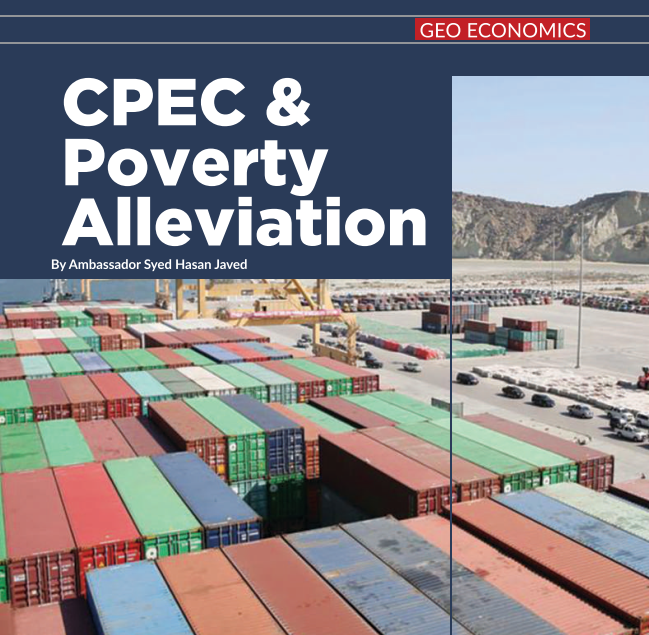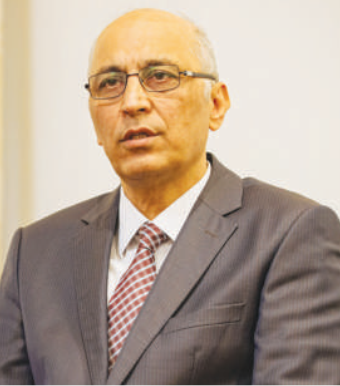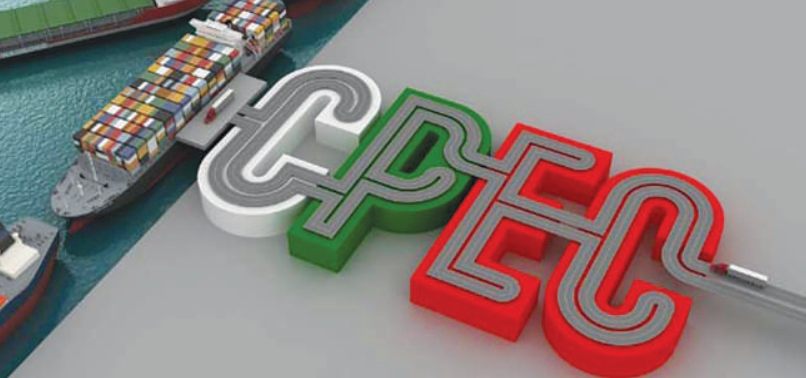
By Ambassador® Syed Hasan Javed
CPEC is human and citizen centric initiative to uplift the welfare of Pakistanis devoid of market connectivity, creating around seventy thousand plus job opportunities. It would provide a sustainable livelihood to almost half of Pakistan’s youth entering the job market in the next ten years.
Generally, China Pakistan Economic Corridor CPEC worth US$ 62 billion, one of the six corridors of the Belt and Road Initiative and its flagship project and the only bilateral undertaking, is considered as comprising only connectivity, infrastructure and energy projects. Though this is partly true, the CPEC’s actual role, content and context are still evolving and rightly so, equally underestimated by Pakistan’s western educated elite.
One of the many aspects of the CPEC, not well researched or highlighted is its role, potential and impact on poverty alleviation in Pakistan. CPEC is human and citizen centric initiative, to uplift the welfare of Pakistanis, devoid of market connectivity, creating more or less seventy thousand employment opportunities, planned to reach 2 million, by 2030 A.D. The CPEC would roughly provide a sustainable livelihood to almost half of Pakistan’s youth entering the job market in the next ten years.
CPEC can easily attract US $ 100 billion by 2030 AD, if Pakistan can ‘get its Act together’. The fact of the matter is that CPEC has just begun with the completion of its first phase of more than two dozen Early Harvest Projects worth US $ 22 billion.
CPEC can easily attract US $ 100 billion by 2030 AD, if Pakistan can ‘get its Act together’. The fact of the matter is that CPEC has just begun with the completion of its first phase of more than two dozen Early Harvest Projects worth US $ 22 billion. This phase of contracted projects of Energy, Motorways, Gwadar deep sea port and Airport are just the beginning of its three phases. Most of these projects are also referred to as the ‘low hanging fruits’. These were meant to address and overcome Pakistan’s stifling supply side bottlenecks, which had been holding back Pakistan’s economic take off.
Opportunity Knocks at the Door
Though the second phase would continue to field a few infrastructure projects such as ML 1- Railway, Sindh Coastal Islands development zone, the major focus of the Second phase of CPEC (2020-2025) is on reviving Pakistan’s agriculture, rural industrialization, small and medium enterprises(SMEs), special economic zones (SEZs), renewable energy, tourism, electric automobile industry, startups, digital commerce and Green environment.
These would require different capacities and China skill sets, in the Federal Ministries, Provincial departments and even private sector firms and trade bodies. We need cultural expertise to engage China and benefit from its development experience, as indeed China did during the past forty years (1980-2020), to uplift itself from the ‘Sick man of Asia to Global Great Power’. China achieved it all by its own vison, humility, soft power and social capital.
It harnessed the global best practices of economic management and combined it with its socialist governance, meritocratic leadership and Chinese characteristics (values and attitudes). Any society’s success or failure in poverty alleviation has a direct relationship with its ability at wealth creation which in turn depends on its ‘Development Model’.
No Development model anywhere in the world, can be regarded perfect or timeless, because the national, regional and global circumstances are constantly changing. Hence goes the maxim, “change is the only constant in life”. Confucius believed that those who wished to remain happy and relevant, needed to always change. Deng Xiaoping, the father of modern China, not only believed that the centrally planned economy template of China (1949-1979) was inadequate, to address and overcome the development challenges, but also that there was no alternative model of development, which China could replicate. Hence, he decided to develop a “hybrid model of development” for China that would ensure wealth creation and poverty alleviation at the same time.
Moving in Circles
Pakistan confronts deep rooted malaise in governance system, mindset and attitudes of its elite, due to 200 years of British colonial rule and one hundred years of living with the ‘American dream’. Pakistan is a typical example of a developing country which ‘dream like the Americans and live like the paupers’. The 300 years of combined onslaught of the Western values and cultural attitudes on the ruling elite of Pakistan, have been devastating, to say the least, creating self-indulgence, class consciousness, illusions and delusions. Pakistan is however not alone! The other developing societies also confront these debilitating dilemmas.
This is because most liberation movements in the colonial societies, only aimed for political emancipation. Very few decolonized states, indeed achieved economic or cultural emancipation, China, among the few of them. Most decolonized societies were content, as long as they had their own national flags, national anthems, national maps and recognition by the United Nations. They considered these as the sufficient symbols of their national sovereignty.
Agriculture, industrialization and SEZs are major priority sectors of Phase-II of CPEC (2020-2025). And Pakistan needs to learn prom China to introduce reforms in these sectors.
Here lies the problem of not only Pakistan, but all the Developing countries. We may put any color in our national flag, put any number of solemn and holier words in in our national anthem or multiple shades and numerical value in our national paper currency notes, what matters is its ‘exchange convertibility’, which also reflects who exercises domination in the world. Political sovereignty is meaningless ‘hallucination’, without economic sovereignty.
Goodbye to IMF Program
Economic sovereignty does not come easy, because the post 2nd world war Breton Woods system of International Financial institution (IFIs) such as the International Monetary Fund(IMF), the World Bank (WB) and the International Finance Corporation (IFC) ensure that the decolonized societies, remain always at their mercy. Under the pretext of lending, funding and assistance, these institutions perpetuate the continuous impoverishment of the Developing world, in order to sustain an unequal, in- equitable global economic under.
These institutions act ‘hands in gloves’ with the great powers using threats, sanctions coercions, conspiracies, coups and conflicts against the vulnerable, unsuspecting and weak states. The IFIs achieve their objectives, with the help of their trio- tack teams of paid financial hitmen, placed in top policy making positions, the local rent seeking extractive elite and the impotent electoral leadership, courtesy of western liberal democracy system.
These elements ensure political instability, economic indebtedness, institutional meltdown, moral bankruptcy, systemic failures, social decay, national despondency, brain drain and flight of capital. This is the common scenario in all the developing countries, who remain perpetually denied of Economic take-off. Just look at Venezuela, Argentine, Chile, Ukraine, etc. and two dozen others, who were part of IMF program of various fancy names and purposes.
Rise of China a Strategic Gain for Pakistan
But now, that is all becoming history with the rise of China and the advent of the Asian century. China has not been accepted, nor is likely to be accepted by the Anglophone world, led by the United States of America which just trusts only two other states in the world i.e. India and Israel. China is however no Soviet Union, or can be treated as such. The Soviet Union was a category in itself.
The Chinese have many advantages, which the Soviet Union lacked like the diversity and nature of its economic strength, soft power, global solidarity, visionary meritocratic leadership, formidable historical and cultural heritage etc. China is no new kid in global history of Great powers. It has been the single largest benign power with the largest economy, for at least fifteen centuries of recorded human history. Well many would say, CPEC is not the panacea for all the economic issues of Pakistan. True.
Yes, indeed. but the CPEC’s potential to make a critical difference in Pakistan’s economic fortunes are hardly doubted by its most ardent critics or skeptics. The potential of CPEC to ignite and sustain Pakistan’s economic take off for many years, is what pricks the IFIs, USA and their ‘new darling India’. They know that Pakistani nation has all the resource endowments and potential assets to enable it to self-generate wealth creation and achieve poverty alleviations, as indeed China has done.
With the coming together of China, Russia, Turkey, Iran and Pakistan, Central Asia, Africa etc., the dream of USA led Anglophone world to remain dominant in the 21st Century, remains a serious question. The contemporary era is not 1945, when the United States accounted for more than half of global GDP and was also the largest creditor nation, globally.
Key Poverty Alleviation Components
Agriculture, Industrialization and SEZs are major priority sectors of Phase-II of CPEC (2020-2025). Pakistan needs to learn prom China. Agriculture Reforms which included policies for land distribution, building of rural markets, rural credit institutions, rural industrialization and development of fishing, aqua-culture, seri-culture, livestock, horticulture, water reservoirs, replantation, forestry, medicinal plants, tourism. These policy initiatives, boosted by farm mechanization, seeds, fertilizers, research extension work, development of supply chain connectivity and transportation networks helping the rural population in wealth creation and rapid poverty alleviation.
Pakistan confronts deep rooted malaise in governance system, mindset and attitudes of its elite and is a typical example of a developing country which ‘dream like the Americans and live like the paupers.
The rural poor in China constituted seventy percent of the total ninety percent of those living under contemporary poverty line of US$ 2/- a day in 1980. In order to decimate poverty, the reformist leadership in China undertook to fully harness its advantages of surplus rural labor, which was only half employed during the seasons of sowing and harvesting. Under carefully planned program Township Village Enterprises (TVEs), Small and Medium Enterprises(SMEs), were launched. Further, a scheme to build four Special Economic Zones (SEZs) which subsequently increased to 14 SEZs, all along the coastal areas, were established.
The remittances from the rural surplus labor employed in SEZs, transformed the county, breaking the vicious poverty cycles, like never before. Pakistan needs to holistically engage Chinese companies for relocation under a well thought out strategic framework. The recent establishment of China Pakistan Business Partnership Forum is only the first step in this direction. This needs to be followed up with mobilization of qualified China expertise to make it happen.
Conclusion
Finally, how can CPEC become a tool for Pakistan to generate wealth creation and ensure poverty alleviation, would require multi-facetted policy initiatives and reforms to make it happen. The Anglicized elite of Pakistan is unable to understand the Chinese transformative development experience, for a number of reasons. They are not alone. Other developing societies as well as the developed countries, face this dilemma too. But in my view, it can be done. Pakistan can replicate China’s success story to a great degree.
After all, China learnt from Pakistan, many best practices. The Reforms to ensure that these goals are achieved in Pakistan, require a “paradigm change”. It is pretty clear that the post-colonial and “global rules based order”, is heavily tilted against the interests of the Developing world.
It is indeed a miracle that China could defeat the Western Powers in their game and on their turf, due to its unique assets such as successive generations of visionary leadership, size, population, social capital, cultural values, socialist governance, etc. No other developing country can claim so many advantages. But Pakistan is also among the best blessed and placed nations for the future.

The writer is a former ambassador. Since 2016, he is the director of the Chinese Studies Center, National University of Science and Technology (NUST), Islamabad.




